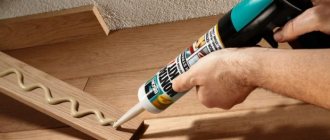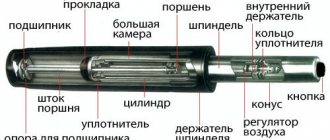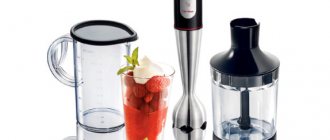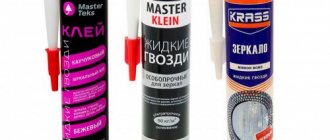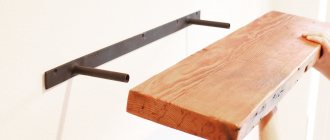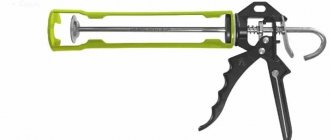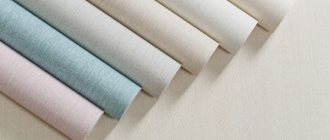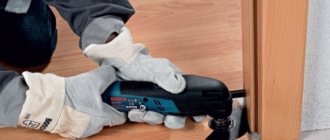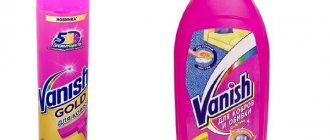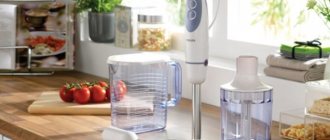Construction of mounting guns
Correct use of the gun makes it possible not only to save foam, but also to do the job efficiently, without the slightest flaw. The design of different models is almost the same. Their design is quite simple. The tool has:
- adapter (reducer): this is a threaded adapter, a cylinder is screwed into it;
- trigger - a trigger mechanism; when pressed, foam “shoots”;
- adjusting screw, used to dose the material output;
- nozzle - a tip that creates the necessary pressure of the sealant;
- handle designed for comfortable use;
- barrel - a cylinder with a channel for polyurethane foam;
- a needle-shaped rod located in the trunk.
The adapter, which is called a gearbox, contains a spring and a ball: these parts require cleaning almost constantly. The adjusting screw, which is responsible for the rate of supply of sealant and its quantity, is handled as follows: if it is tightened all the way, the supply is completely blocked; when it is screwed tightly, the foam comes out heavier. A screw with a gasket located next to the trigger prevents the compound from getting on it.
Instructions for use
Before starting work, you need to open the package with liquid nails and the gun itself, and carefully read the instructions. You should definitely check the expiration date of the glue: if it has expired, then such a product is not suitable for installation. Water-based compounds should only be used at temperatures of +5 degrees and above. Solvent-based liquid nails can be used even at sub-zero temperatures.
Operating rules
To ensure that the adhesion of the composition to the surface does not decrease, it is necessary to carry out a number of preparatory measures. All dirt, dust, debris are removed from the base, and the remnants of the old, peeling paint coating are removed. To degrease, wipe the base with alcohol, acetone or a special degreaser. Materials that are too porous are treated with 2 layers of primer. Smooth, shiny surfaces, on the contrary, are sanded to increase the adhesion strength of liquid nails.
Before inserting the glue cartridge into the gun, it is important to make sure that it fits exactly in size (it is better to take measurements before purchasing). If the gun is old, it is inspected for the presence of dried drops of glue or sealant; if necessary, they are wiped off with a solvent or scraped off.
Then load the tube into the gun in this way:
- remove part of the plug and screw the nose of the extension onto the thread;
- cover the tip of the extension with a cap;
- pull the rod towards you, making room for liquid nails;
- insert the tube into the body, move the rod to the bottom so that the disc rests tightly against the piston;
- if the gun begins to warp (this happens with low-quality models), wrap it with construction tape, electrical tape or wire.
Working with a pistol
The supply of glue can be continuous or intermittent. In the first case, a solid line is formed, and for this purpose the pistol trigger is pressed constantly, with the same force. Also, the adhesive composition can be applied in the form of a snake or mesh, which is ideal for attaching ceramic tiles.
Applying liquid nails with a snake
For the second method, the product is applied spotwise or distributed in strips of the required length. This method is more popular because it allows you to use the product more economically. In addition, too much liquid nails will cause them to dry slowly.
After distributing the composition on the surface, proceed as follows:
- connect the parts to be glued together;
- squeeze them tightly, applying force;
- hold the elements for a minute manually or with clamps, or under pressure;
- remove excess spilled composition;
- Leave the surface without use until completely dry (about a day).
Fixing the parts to be glued with clamps
Applying liquid nails without a gun
It happens that you don’t have a gun at hand, so you have to apply the chosen product without his participation. It would be inappropriate to purchase a device for one-time gluing of small parts or applying a couple of small seams: all work can be done manually. Experts advise using one of the options below:
- Take a cap from a 5 liter plastic bottle and make sure it covers most of the bottom of the cartridge. Place it on a suitable sized wooden block or hammer handle. Using such a device, press on the bottom of the tube so that the composition begins to protrude from it. If you act carelessly, the packaging may become warped or its walls may be damaged. You should not use a block without a cork - the pressure on the bottom should be uniform.
- If the liquid nails package is made of soft material, it can be pierced for use. It is better to puncture in the bottom area or where it can then be sealed with electrical tape without any problems. After a hole appears, you need to squeeze out a little glue through it and spread it over the surface with a narrow spatula. This method is quite inconvenient, because the yield of the composition is difficult to control.
Liquid nails in packaging for manual extrusion
- The easiest way to apply the product without a gun is to immediately purchase liquid nails in a package for manual extrusion. It has a stopper and a comfortable thin spout, with which it is easy to make an even, continuous seam. If liquid nails will be applied to the seam, it is advisable to cover the edges of the two products with masking tape in advance. The tape should be removed immediately after completion of the work, without waiting for the composition to set.
Advantages and disadvantages
The use of a mechanized method has many advantages compared to manual application of liquid nails:
- simplicity and high speed of operation;
- ease of device control;
- pistol versatility;
- convenient design, reliability;
- possibility of applying the product in hard-to-reach places;
- obtaining an even, neat and beautiful seam.
Using a gun makes working with glue easier
You don’t need any special skills to operate a pistol—even a beginner can learn it. The container with the composition can be easily replaced if it runs out of liquid nails. The disadvantages include the high cost of really high-quality devices, although for one-time work you can buy a cheap mounting gun. In addition, the glue tool will have to be cleaned, and as quickly as possible - otherwise it will be difficult to rid it of glue drops
Battery devices need to be charged regularly, and for electric devices to work, it is important to ensure that there is a network nearby
Liquid nails Moment: how to use correctly
Today, a construction adhesive called “liquid nails” is used to connect various surfaces. The substance is used in construction, finishing and repair work.
The classic nail composition is based on synthetic rubber and a special type of clay mined in Texas. The addition of titanium dioxide gives the glue a white color. To reduce the cost, chalk is used (instead of expensive clay), which accordingly worsens the quality.
The toluene contained in the composition is responsible for adhesion, but slows down drying. To reduce this time, acetone is added to the material.
Product Features and Applications
Liquid nails are a construction and installation adhesive based on polymers and synthetic rubbers, which allows you to fasten materials of different structures, providing a high degree of adhesion (adhesion) of surfaces. The product is produced under several brands. The composition and properties of specific products may vary. In any case, manufacturers claim that the glue can withstand loads of up to 90 kg/cm². The product is sold in cartridge tubes with a volume of 0.3 liters or more.
The basic composition of liquid nails includes synthetic rubber, polymers and fine filler. It is the presence of the last component that distinguishes this glue from the rest. It allows you to firmly connect surfaces that do not fit tightly.
In the classic version of Liquid Nails, Texas clay, which has increased plasticity, is used as a fine-grained filler. Many manufacturers replace it with chalk (calcium carbonate), but its adhesive properties are worse.
But they are toxins for humans. A sign of their presence is a sharp, suffocating smell.
The main areas of use of liquid nails are fixation of various materials:
- ceramic tiles;
- cork panels;
- plastic;
- drywall;
- wood;
- aluminum, teflon;
- glass, mirrors;
- ceramics;
- chipboard, OSB, fiberboard;
- polyethylene;
- polystyrene foam;
- concrete, gas and foam blocks, bricks;
- heavy wallpaper on a natural basis and so on.
In addition, the adhesive can be used to seal seams and cracks in bathrooms, window and door openings, walls, furniture and so on. But its effectiveness compared to special sealants is questionable.
Considering the relatively high cost of liquid nails, it is not advisable to use them for connecting large structures. For example, you should not use it to tile the entire bathroom. But gluing individual parts is quite reasonable.
Sequence of gluing parts
To release the glue from the tube, you need to press the gun handle with frequent hand movements.
The threaded head of the tube is cut off with a sharp knife or the membrane is pierced with a sharp object. A conical tip is screwed onto the head and the cap is removed from it. The edge of the tip is cut at an angle of 45°, and the cap is put on again. The glue cartridge is ready for use.
Before inserting the cartridge into the gun, the operating rod must be relaxed. The tube is inserted into the device; by pressing the trigger, the rod is clamped until it stops. The cap is removed. By frequently pressing the handle, the glue is applied to the surface in an even strip or dotted fragments. To glue large surfaces, a mesh or snake is applied.
The surfaces to be glued are pressed and, if necessary, fixed with additional devices. Individual flat parts can be pressed down with a press. Some types of glue set within 1-2 minutes.
The total bonding time of the parts is usually 12-24 hours.
The area of surfaces prepared for gluing should be taken into account. Do not completely cover large surfaces to be glued with glue and do not apply excess glue. This will increase the setting time of the composition. To glue decorative parts, the cut is made with the smallest distance from the end of the cone.
Excess glue that appears is wiped off with a rag soaked in solvent. Glue stains remaining on wood parts can be washed off with a special cleaner. The glued structure can be used no earlier than after 24 hours.
In any large-scale repair, we resort to the help of assembly adhesive, however, not everyone knows how to use this composition correctly. It is likely that each of us will figure out how to open the mounting adhesive
, but not everyone knows how to insert it into a gun. Adhesive joints in repair work are simply irreplaceable when attaching laminate or parquet boards, wall and ceiling panels, baseboards, stucco moldings, and various decorations.
Modern adhesive compositions sold as “liquid nails” are cartridges with a volume of 400 to 310 g; there are also more economical options - 200 g, which are suitable for small jobs. Any product indicates how to use the composition correctly and what materials it is best suited for, but not all manufacturers indicate how to use a glue gun
.
Correctly opening the mounting adhesive:
- So, first you need to strictly follow the instructions on the cartridge label: the nozzle should be cut at an angle of 45° to the mark.
- The membrane is opened with a knitting needle or other sharp object.
- Then we install the nozzle on the opened cartridge and insert it into the mounting gun - loosen the working rod of the tool, insert the tube into the niche and clamp the rod all the way, the main thing is not to create strong tension in the tube.
In general, nothing complicated, now you know how to insert mounting adhesive into the gun
. The glue is applied in dotted drops, a process similar to driving in regular nails. For bonding strength, a continuous application of the adhesive composition to the surface is not required; to fasten heavy parts, the composition is applied in a thin strip.
To remove the liquid nail cartridge from the gun, you need to press the locking tab and, holding it, pull the rod towards you until it stops. Then we move the cylinder forward a little and pull it out of the gun.
Please note that after completing work with liquid nails, it is recommended to immediately clean your hands and tools of the adhesive, otherwise, after drying, this will be quite difficult to do. Organic-based construction adhesive is best washed off with acetone, white spirit and toluene; water-soluble compounds should be rinsed well with water.
If you are unable to figure out how to use a liquid nail gun
or you think that you can handle it on your own and are not planning to purchase this tool, we recommend that you study in detail the instructions for working with the composition. For a small amount of repair work this is quite possible.
How to use liquid nails without a gun?
If you open a new tube of mounting adhesive, you can easily squeeze out the contents by pressing your finger; otherwise, you will need a stick, for example, the handle of a hammer. The main thing is to be careful; you cannot turn over the cap that closes the container, otherwise all the adhesive will spread and the tube can be thrown away.
Some people don't quite understand how to use liquid nails.
This is not surprising, since this device is relatively new on the building materials market.
The article explains how to use liquid nails and which ones are best to choose.
How to remove the solution
Even when working with a gun, there is a possibility that glue will get on furniture, hands or other elements in the room. In this case, you will need to remove it immediately. To do this, it is advisable to use a solvent, but this option is only suitable for quickly removing fresh glue.
If the adhesive has already hardened, then only a special cleaner is used to remove it, and you can also use a scraper, but it can damage the coating.
A liquid nail gun, the instructions for use of which are indicated above, is considered an excellent choice if you need to use a high-quality adhesive to connect different specific surfaces. It greatly simplifies this procedure, and also ensures that the solution does not get on other objects in the room where the work is being carried out.
When carrying out repair and construction, finishing, installation work, as well as work on decorating a room, construction glue is used, better known in everyday life as liquid nails - Liquid Nails. This special construction adhesive is made on the basis of polymers and rubber and is supplied to the market in tubes of various capacities or in cylindrical cartridges (tubes). For the convenience of working with cartridges, it is customary to use a special construction (installation) gun for liquid nails, which is designed for dosed application of glue to the surfaces to be glued.
Liquid nails will help in tiling
This gun is used for working with various sealants, which are packaged in similar special tubes with a standard volume of 310 ml. This tool got its name because of the principle of operation - the adhesive composition is applied by pressing on the trigger, which is why it is compared to the weapon of the same name. Although the process of applying glue itself is more similar to the operation of a syringe.
When choosing liquid nails, study the instructions on the packaging to find out whether this construction adhesive is suitable for the types of surfaces that are to be glued.
Like similar construction tools, mounting guns are divided into two main types: household (mechanical) and professional (pneumatic and battery-powered).
Professional ones are usually used to apply all kinds of sealants, and three types of mechanical guns are used to work with liquid nails.
An inexpensive type of liquid nail gun is a semi-body gun. Such pistols are short-lived and not easy to use. The stand for the cartridge with construction adhesive seems to be cut in half and during operation the tube often warps, which interferes with the smooth movement of the rod.
For the home craftsman, there is a simple solution to this problem - the tube is tightly fixed in the gun body using wide tape. Wrap tape around the tube placed in the body, closer to the handle. At the same time, they protect the branded sticker, which is located on the case. There is a manufacturer’s warranty for such working tools, and in order for the gun, if necessary, to be returned under warranty, it is advisable not to damage this sticker.
The next type of mounting gun is the most popular among buyers and is called skeleton. It is a little more expensive than the half-body, but it holds the liquid nail cartridge more securely, allowing the glue to flow more smoothly. However, even here, tape is used to secure the tube tightly, since cases for inexpensive pistols are made of aluminum, which does not provide sufficient rigidity.
The most convenient for working with liquid nails is a tubular (syringe) gun. It tightly fixes the cartridge with glue or sealant, and is used not only for working with tubes, but also with foil packaging, which is used for packaging certain types of sealants.
Types of construction guns
Despite the existence of different types of mounting guns, they can all be grouped as follows:
- professional;
- household
Professional mounting gun Hilti
Professional pistols
Such devices are designed to regularly perform a significant amount of work and are more suitable for construction and repair specialists. They are necessary if speed of application of compounds is required, because their performance is at a high level. The cost of such devices is 2000-15000 rubles, so purchasing them for home use is impractical.
Depending on the design, pistols are divided into the following types:
- Pneumatic. The glue is pushed out under the pressure of the air flow, which is regulated by the controller and the locking lever, and is activated when the trigger is pressed. These guns can operate continuously. They are suitable for most types of liquid nail cartridges.
Pneumatic gun for adhesive composition
- Electrical. They are powered by the electrical network, are economical in terms of labor costs and composition consumption, and operate smoothly but quickly. The cost of such pistols is the highest. They cannot be considered mobile; they require a power outlet to operate.
- Rechargeable. They also operate on electricity, but are powered by rechargeable batteries (accumulators). Such devices can apply liquid nails even where there is no power supply. One charge is usually enough for 1.5-2 hours of continuous work.
Household pistols
There is no need to use professional devices at home. There are mounting guns on sale that are inexpensive and quite suitable for one-time work:
- Skeletal. The price of such devices starts from 200 rubles. They are an open aluminum “syringe” with a piston and two guides between which a cartridge of liquid nails can be clamped. The skeleton pistol will serve the master for quite a long time - at least 20 cartridge changes.
- Half open. They are considered a very budget option for the home, costing from 120 rubles, however, they can break after a couple of used glue cartridges. A weak attachment of the tube, which will dangle in the gun, and for this reason the glue seam will remain uneven and intermittent, can also cause inconvenience to the master. The problem can be solved by gluing the tube in the gun with construction tape.
Semi-open type liquid nail applicator
- Tubular. These are universal devices that look like hollow syringe tubes with a piston. The container with the cartridge is firmly fixed here, and it is also possible to use adhesives and sealants in “sausages” and other soft packaging. Tubular guns ensure uniform application of the compositions and are designed for fairly long-term operation (up to 50 cylinder changes).
Safety rules and completion of work with liquid nails
It should be remembered that the composition of liquid nails can be toxic and flammable. This applies to materials made from artificial polymers. Such components have a pronounced chemical odor. When working with such materials, you need to wear a special mask, gloves and a room with forced ventilation.
Water-soluble mixtures are more environmentally friendly. But they dissolve with constant exposure to moisture and are not recommended for adhesion of metal structures.
- Before starting work, make sure that the LG packaging is intact.
- Store installation materials away from heat sources, at room temperature and out of reach of children.
- If you use power tools to spread the adhesive, check that the voltage is correct and that the insulation is intact.
- If the product gets on exposed skin or eyes, rinse immediately with running water.
After the work is completed:
- Close the packaging with the material tightly, otherwise the solution will quickly harden and the packaging can be thrown away.
- If you use special tools, disassemble them and wipe them with liquid to remove the adhesive component.
- Store equipment unassembled.
- If excess glue has not yet dried, it can simply be removed with a clean napkin.
- Hardened residues can be removed using special liquids for dissolving repair mixtures.
- If there is no fear of damaging the surface, you can scrape off the dried glue using a mounting blade.
- After gluing the elements, you should wait at least a day for the final adhesion of the surfaces.
Some tips:
Area of use and differences between types
Liquid nails are popular in construction and renovation. Purchase them for any task. The cost is low, equal to half the cost of polyurethane foam.
A common example of using liquid nails is fastening materials to brick structures, gluing wooden surfaces, fixing fiberboard and chipboard sheets. Nails are also used for gluing ceramics, polystyrene, glass or even metal; with their help it is easy to glue foam.
A useful function due to which liquid nails are valued by professional builders is gluing surfaces that do not fit tightly together. When using liquid nails, to fix such surfaces you will need to squeeze out a little more from the tube.
Restrictions on the use of liquid nails - they are not used for gluing damp or damp wood; they cannot be used to glue an aquarium, not even because of constant contact with water, but because of the slow decomposition and subsequent poisoning of the inhabitants. Silicone sealant is suitable for these purposes.
Liquid nails are used in small decorations, when you need to efficiently but discreetly fix an element on a wall or ceiling, glue a torn part, etc.
Liquid nails are purchased from different manufacturers and in different volumes, which also affects the price.
If you perform a small amount of work, then a minimum amount of liquid nails is enough; for a large front, purchase a large tube. The larger the volume, the lower the total cost.
Which liquid nails are best to use: advantages of Titebond
Glue has become an indispensable assistant in repair and construction work of varying complexity. It allows you to glue elements made of stone, concrete, metal, wood. Liquid nails are applied to various surfaces.
The greatest effectiveness of glue is achieved by using the appropriate brand for a particular situation. The instructions describe in detail the areas of application of the products. But among the large number of species, common characteristics are distinguished:
- Practicality and ease of use. People who do not have the skills to carry out repair and construction work will be able to use “Titebond”;
- Applying material to uneven surfaces. In this case, the load is distributed evenly along the entire perimeter. This reduces the pressure exerted on the bonding site;
- Construction adhesive remains flexible after drying;
- Titebond liquid nails withstand vibration and are resistant to deformation;
- Retain properties for many years. Construction adhesive is resistant to temperature changes and chemical influences - acids, alkalis, salts.
How to use?
Nails are very often used during installation. Despite the fact that working with them is relatively simple, you still need to follow a few rules.
For example, you should remember that glue is applied only to a clean, dry surface. In addition, after spreading the solution, you must press the parts tightly in the desired position for 2 minutes.
You should also remember that the glue is applied in strips or dots. In this case, there is no need to spread the composition over the entire surface; gluing will be good without it.
Drying usually takes about 12 hours, but it can last 18 hours or a day - it depends on the brand and manufacturer. It is better not to touch the structure while it is drying.
If the gluing elements are quite heavy, then it is advisable to wait a week, then the glue will dry completely and will be able to completely hold the structure.
We should not forget that nails based on organic compounds are quite dangerous - you should not allow the composition to come into contact with the skin. The glue must be applied with a special gun.
In stores, liquid nails can be found in the form of cartridges, which helps to use the adhesive solution in doses and save money. At the same time, the shelf life of the composition is quite long.
However, everyone has situations when they need to not only apply glue, but also remove it. High-strength adhesive mortar is especially difficult to remove.
To remove newly applied liquid nail, you should try washing it off with water and solvent. You can use a regular sponge for this.
However, this option is not yet the most difficult, since the composition has not yet had time to dry. If the glue has already dried, you will have to wash it off with special substances that are available in stores.
However, not everyone has strong solvents on hand. For such cases, the use of a conventional scraper is indicated. You just need to work with it very carefully so as not to spoil anything.
You can try to heat the frozen glue. In this case, the mass will become liquid and viscous, it can be easily washed off, you just have to heat it up to 60 degrees.
Many people still have the question of how to properly use a nail gun. This is also quite simple - you need to press the metal tongue of the gun, then pull the piston in your direction, which will make room for the adhesive solution.
After fixing the cylinder, you need to press the piston back, and then you can squeeze out the nails by pumping the trigger.
Some people don't know how to open a tube of solution. This question is often asked by beginners, but in fact there is nothing complicated here.
The tube is either sealed - then you need to open it with a knife, or you just need to pierce it from the top if the container is tin. It is best to pierce with a nail, because there is a protective film inside.
A gun is used to apply an adhesive such as liquid nails to the surfaces to be bonded.
Let's look at what types of this tool there are, what to look for when choosing
Rules for using LG
To achieve the effect of using liquid nails, apply them to a dry and grease-free surface.
Apply either pointwise with small increments, or in stripes. Do this quickly so that you can then press the surfaces to be glued together. They are fixed in a tight position to each other for several minutes (2-3), after which it remains to wait for complete drying.
To find out how long liquid nails take to dry, the answer to this question is on the label. Depending on the manufacturer and type of nails, the time varies. This period lasts from 18 hours to a day. During this time, they do not create additional load on the bonded surfaces.
Users make the same mistake, which does not give a positive effect and increases the consumption of nails. They are applied to only one surface, the second is degreased and cleaned of dust.
Nails are applied using a special gun, which is designed for gluing materials in hard-to-reach places.
Squeeze out liquid nails without it, pressing on the bottom with a suitable object. But it is worth cautioning: the bottom will be damaged and then the liquid nails will leak out, making it impossible to use them.
What is it used for?
Recommended uses include a variety of products including wood, silicate glass, ceramics, organic glass, aluminum alloys, natural cork, plasterboard, foam polymers, siding, wood fiber boards or shavings.
High-strength adhesives can be used to secure sinks and other plumbing fixtures, window and door frames, baseboards, countertops and mirrors. Sometimes craftsmen use liquid nails instead of sealants; they are used to insulate seams, fill microcavities, cracks in walls, ventilation ducts, and corner joints of design structures.
How to clean the surface
The procedure for removing excess or residues of liquid gas has several solutions and depends on the time of application and the material on the surface of which it is applied. Let's list the main ones:
- Fresh residues can be removed with a sponge and warm water (or mineral solvent);
- Dried adhesive can be removed with a special cleaner. It is sold in hardware stores;
- If cleaner is not available, a scraper or blade can be used, although this is not suitable for all surfaces;
- Another option for dried glue is increasing the temperature. Since liquid gas generators are operated at a temperature (as a rule) of no more than 50°C, then when heated to 55-65°C, the composition goes into a semi-liquid state and is removed with a scraper;
- An exotic option for old glue is exposure to direct sunlight. Again, we use the “weak points” indicated in the instructions. Staying under the rays softens the liquid gas, subsequently mechanical cleansing with washing is carried out (see the first option).
In general, liquid nails are an effective “lifesaver” for small household repairs. The photo above shows my personal choice. This glue from the company Macroflex has proven itself amazingly in many repair work, especially since it has a very affordable price. Don't take this as an advertisement, take my word for it, I know what I'm saying. I will end here. I hope it was informative... Subscribe to the blog, introduce friends and comment on articles. Hearing an outsider's opinion is always useful...
An anecdote on the topic: Few people know that in the Moment glue production workshop there is always a rosy and positive atmosphere.
Good luck to you in your family affairs and, of course, in construction! Bye!
Wisdom Quote: If all men thought alike, no one would gamble at the races (Mark Twain).
Description of the device operation process
First you need to figure out how to properly place the container with “liquid nails”. It is unacceptable that the seal of the package is broken if installed incorrectly, otherwise the glue will dry out and it will hardly be possible to use it.
Before using the gun, you need to prepare the following things:
- a bottle of “liquid nails”;
- sharpened knife;
- glasses and gloves for protection;
- a breathing mask if you plan to use an adhesive mixture prepared yourself;
- a dry rag to remove excess adhesive;
- a solvent, due to the fact that the glue may accidentally get on the skin or some surface.
The principle of operation of the tool is quite simple - after pressure is applied to the cylinder mechanically, the adhesive substance “comes out” of the cylinder. The pressure is provided by a rod, which is activated by acting on the trigger lever. In pneumatic mounting units, pressure is supplied by air. Difficulties arise when you need to choose the appropriate glue. As a rule, manufacturers use the same standards, that is, glue can be selected for any gun.
Next, pull the rod out of the device; to do this, mechanically act on the lever and remove the rod. Instead, install the tube and press the release lever 2-3 times with little force to strengthen the balloon.
Poke a hole in the container, glue will flow through it to the tip.
If you decide to use a tubular tool, it is charged differently. First you need to make a hole in a container with “liquid nails”. The container with the adhesive must be fixed so that the cut end of the container is directed towards the tip from where the glue will “come out”. Before installing the cartridge into the tool, you must remove the rod.
As a rule, the kit comes with several nozzles with tips; use one of them to tighten the cylinder. If there is no hole on the tip, then you need to cut off a very small part with a knife at an angle of 45 degrees. Then gently press the trigger lever and move the glue along the pre-applied markings. If you use a skeletal or semi-open instrument, then in order to fill the void in the cap, you must first press the trigger lever several times, and then perform the actions smoothly.
Before the gluing procedure, the surfaces must be cleaned and degreased. Then apply “liquid nails” in a thin layer or in dots. If the surfaces to be glued have a large area, for example, ceramic tiles, then it is necessary to apply the adhesive on them in the form of a snake or mesh. Afterwards, the surfaces to be glued need to be pressed against each other; if necessary, they should be fixed with special structures. Flat parts can be placed under the press. Some types of glue set within 1-2 minutes.
How to work with the composition?
Before applying glue, it is necessary to clean and degrease the surfaces. The nails are applied with a 2 cm indentation from the edge so that the glue does not come out of the seam when squeezed. If the surface is uneven, then apply it pointwise. For small surfaces, you can apply it with a line, to give greater rigidity and increase the adhesive force. For example, for ceiling tiles it can be applied in a continuous line around the perimeter, for wall panels - in small sections.
The glue should be applied according to the instructions. If the nails are acrylic, then apply glue and press, holding for several minutes until it sets. If the nails are rubber, then apply glue, connect the surfaces, and immediately separate them so that the solvents evaporate, making the bonding easier. Leave for 5-10 minutes and finally connect, pressing. If the structures are heavy, then use supports.
If excess does appear, then before it dries, you can remove it by scraping it off with a plastic card like a spatula. Acrylic nails can be wiped with a damp cloth, rubber nails can be removed with a solvent. If the surface is porous, then such manipulations will ruin the appearance. In this case, it is better to wait until the excess glue has dried and carefully cut it off.
Device operation
An additional advantage of using guns is the simple operating principle of the tool. After placing the sealed cylinder on the platform and securely fixing it, you need to pull the trigger. It activates the rod-rod, which, in turn, moves the disk piston, which acts on the base of the cylinder. Under pressure, the glue flows out of the tip of the tube. How to use a liquid nail gun:
- You need to put a sealed package with glue on the tip.
- Before use, you must ensure that it is securely attached.
- To reduce the pressure in the tube, the trigger is pulled back slightly.
- If the bottle is not installed correctly, the liquid nails will dry out.
- Before installing the nozzle, you need to check that there is no restrictive bottom on the tube.
To open liquid nails for a skeleton or semi-open gun, you need to remove the lock from the base of the cylinder, remove the stem (retract it) and secure the tube. You need to press the lever with some force two or three times to finally fix the cylinder. You need to pierce a hole in the container through which liquid nails will flow to the tip. A tubular gun, which works on the principle of a syringe, is filled in the opposite way - with the cut end of the tube towards the tip. Before installation, the rod is removed.
The mounting adhesive is supplied with tips; after opening the container, the cylinder is screwed on with a suitable attachment for the job. If there is no hole on it for squeezing out liquid nails, you can do it yourself - with a small diameter at an angle of 45 degrees. By mechanically pressing the lever, the amount of glue is dosed and the gaps and seams are evenly filled.
Design and principle of operation of a pistol for burning gas
The design of a construction gun for liquid nails is universally simple and consists of six main elements:
- Platforms for holding the cartridge;
- Handles (in some models rubberized);
- Trigger;
- Feed rod;
- A pusher disk attached to the rod;
- Locking (fixing) tongue;
The principle of operation of this tool is as follows: after the cartridge with liquid nails is installed in the gun platform, pressing the trigger activates the rod, which pushes the disk. In turn, the disk exerts pressure on the bottom of the tube and squeezes the contents through the hole in the tip of the tube onto the surface.
In more expensive models, after releasing the trigger, the mechanism moves the rod back a little. This relieves excess pressure in the tube and prevents excess glue from leaking out.
No. 1. Composition of liquid nails
Liquid nails were invented in the USA. There, in the 60s, Macco first decided to package regular glue in individual cartridges for ease of use. A couple of years later, a new development appeared - Liquid Nails
. In just a few years, liquid nails have conquered American users with a host of advantages, but they only entered the domestic market in the 90s.
The basis for the new type of glue was synthetic rubber
with polymer additives
.
A special type of clay
was used as a filler . In the USA, huge deposits of this clay are concentrated in the state of Texas, where the main industrial facilities of most local manufacturers are located. Today, instead of unique clay, ordinary chalk is often used. In this way, manufacturers kill two birds with one stone: on the one hand, chalk acts as a filler, but at the same time it gives the glue the necessary white color, which is achieved using classical technology by adding titanium oxide. Glue with the addition of chalk is significantly inferior in terms of quality.
Previously, toluene was added to liquid nails to improve adhesion and acetone to speed up drying. The increased toxicity of these substances forced them to abandon their use. However, some companies still use similar additives to reduce the cost of the composition. Their adhesives have an unpleasant odor and, as a rule, a suspiciously low price. Under no circumstances should such compositions be used indoors.
The best brands of glue - selecting the composition for certain materials
Of course, useful tips for using the adhesive can be read on its packaging. But what if you come to the store and you need to choose an adhesive that is optimal for a specific material. Not all sellers are competent in such matters. Therefore, it is worth considering the highest quality compounds that have proven themselves in certain cases.
Most popular composition
One of the most popular compositions among buyers is Extra-Strength Moment Installation produced by Henkel. This is a good glue that is suitable for fixing heavy types of facing materials: natural stone, wood, metal siding. But if you use materials such as polystyrene for your work, then this glue will not suit you. In such situations, it is worth buying the Superstrong Moment Installation composition, made on a water basis. Do not forget that liquid nails of this type are not suitable for Teflon and polyethylene.
For work inside the house, composition LN601 from the manufacturer Macco is unrivaled. This neoprene backed adhesive is great for many construction and renovation jobs. It glues plywood, natural wood, chipboard, metal and plastic moldings equally well. However, this composition will not be able to cope with the installation of ceramic tiles and mirrors. Because of this, there is no point in buying it for bathroom renovation.
Another glue that will become a reliable assistant in repairs and construction is the Multi-Purpose composition of the Russian company Titebond. It is also made on a neoprene base and is suitable for wall cladding with metal, plastic, wood, fibreboard, chipboard and ceramics. Thanks to its good adhesion to brick and concrete walls, this adhesive will hold even the heaviest finishes. The only area where such liquid nails are not used is swimming pools. In addition, it is not suitable for working with polystyrene.
Experts often have their own opinions about what glue can be used when working with certain materials. Based on the words of the pros, water-soluble, quick-drying compounds Titan WB-50 or Solvent Free are ideal for installing ceramics. They withstand light vibrations and moisture very well. For the purpose of gluing mirrors, adhesives that do not contain substances that dissolve amalgam will be optimal. Among them, it is worth highlighting LN-930 and Zigger 93. When renovating a bathroom, it is recommended to use compounds with increased resistance to moisture. Among these, Nail Power and Tub Surround stand out.
